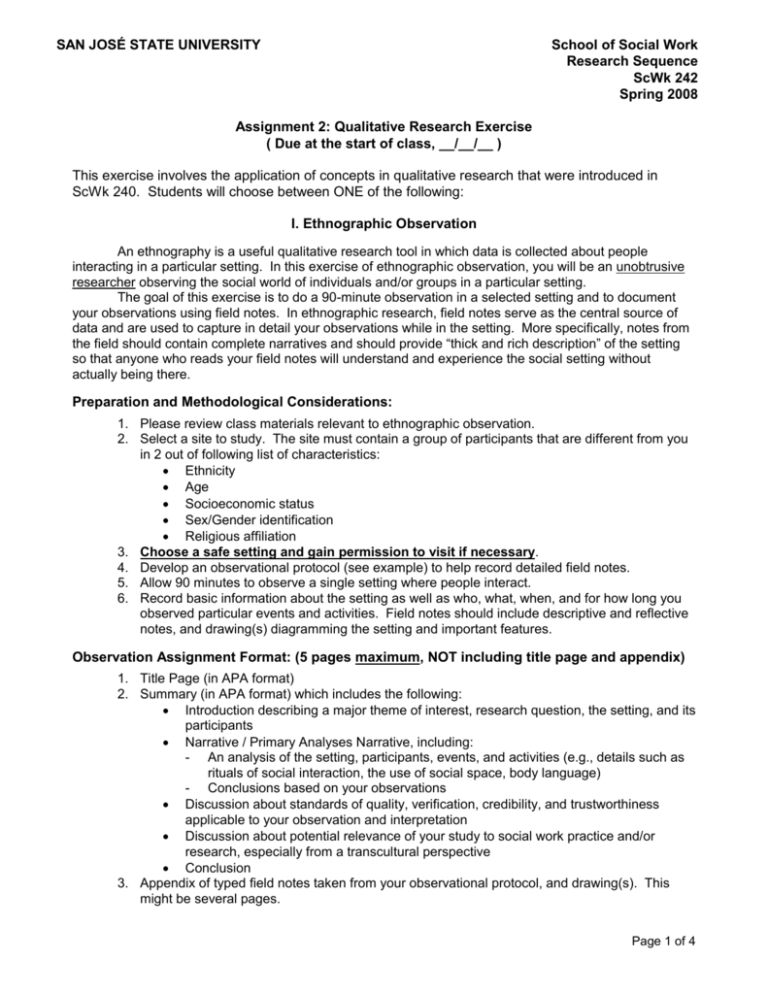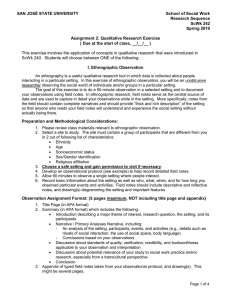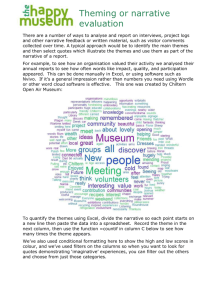Oral History Guidelines - San Jose State University
advertisement

SAN JOSÉ STATE UNIVERSITY School of Social Work Research Sequence ScWk 242 Spring 2008 Assignment 2: Qualitative Research Exercise ( Due at the start of class, __/__/__ ) This exercise involves the application of concepts in qualitative research that were introduced in ScWk 240. Students will choose between ONE of the following: I. Ethnographic Observation An ethnography is a useful qualitative research tool in which data is collected about people interacting in a particular setting. In this exercise of ethnographic observation, you will be an unobtrusive researcher observing the social world of individuals and/or groups in a particular setting. The goal of this exercise is to do a 90-minute observation in a selected setting and to document your observations using field notes. In ethnographic research, field notes serve as the central source of data and are used to capture in detail your observations while in the setting. More specifically, notes from the field should contain complete narratives and should provide “thick and rich description” of the setting so that anyone who reads your field notes will understand and experience the social setting without actually being there. Preparation and Methodological Considerations: 1. Please review class materials relevant to ethnographic observation. 2. Select a site to study. The site must contain a group of participants that are different from you in 2 out of following list of characteristics: Ethnicity Age Socioeconomic status Sex/Gender identification Religious affiliation 3. Choose a safe setting and gain permission to visit if necessary. 4. Develop an observational protocol (see example) to help record detailed field notes. 5. Allow 90 minutes to observe a single setting where people interact. 6. Record basic information about the setting as well as who, what, when, and for how long you observed particular events and activities. Field notes should include descriptive and reflective notes, and drawing(s) diagramming the setting and important features. Observation Assignment Format: (5 pages maximum, NOT including title page and appendix) 1. Title Page (in APA format) 2. Summary (in APA format) which includes the following: Introduction describing a major theme of interest, research question, the setting, and its participants Narrative / Primary Analyses Narrative, including: - An analysis of the setting, participants, events, and activities (e.g., details such as rituals of social interaction, the use of social space, body language) - Conclusions based on your observations Discussion about standards of quality, verification, credibility, and trustworthiness applicable to your observation and interpretation Discussion about potential relevance of your study to social work practice and/or research, especially from a transcultural perspective Conclusion 3. Appendix of typed field notes taken from your observational protocol, and drawing(s). This might be several pages. Page 1 of 4 Observation Protocol Example (Creswell, 2007, p. 137) At the top of your protocol, include information for the observation’s location, date, and time of day Your observation protocol can be any page length. It should have columns at least for “descriptive notes” and “reflective notes” Include details, including what you directly observe and sense, and your impressions or questions Your diagram can be simple, like the picture fit into the column below. Observation Protocol Location: Campus Classroom Date: Tuesday, October 5th, 2004 Time of Day: 5:00 to 6:30om Page 1 of 19 Or it can be complex, drawn separately, with greater detail and from multiple views or exemplifying spatial changes over the observation period. The goal is to be detailed enough so that you and the readers understand the setting, the use of space, who/what is in it, and the general environment for context. If you are uncomfortable drawing, try using a computer program or camera. MAKE SURE you are ethical and sensitive if you take pictures. Creswell, J. W. (2007). Qualitative inquiry and research design: Choosing among five traditions (2nd ed.). Thousand Oaks, CA: Sage. Page 2 of 4 II. Oral History Gathering the “oral history” of a respondent is another useful qualitative research tool that provides an intimate glimpse into the person's subjective view of the world. The use of the word "history" in this context is perhaps a misnomer because the sample is limited to just one person's perceptions. It is methodologically invalid to project this into a true, empirical historical portrait of events, which requires the corroboration of several testimonials as well as of documentary or archeological evidence. A life history is at best a fragment of a larger story. History per se is sometimes referred to as “collective memory" in order to distinguish it from the subjective life history of an individual. Memory is a creative process. The structure of memory is the participant’s accounting of events, themes, characters, and the descriptions/explanations behind them, including what is recalled and highlighted as well as forgotten and omitted. All of us structure our memories, selecting that which is important to our sense of self, and de-emphasizing or selectively “forgetting" other events which are not consonant with the “story” that we have evolved over the course of our lives. Sometimes there is a tendency to focus on positive events, but negative events may also play a crucial role in one's definition of self - as a rationale, a justification, or a turning point. An oral history should be viewed as a narrative stating the way in which a person would like to be remembered, rather than as a literal reconstruction of an actual record of the person's life. The goal of this exercise is to do a 60-minute face-to-face interview with a person relatively easily accessible to you within the stated assignment conditions. Notes should be detailed enough for a “thick and rich description” of the particular themes or topics discussed by the person so that anyone who reads your notes will understand and experience the interaction without actually being there. Preparation and Methodological Considerations: 1. Please review class materials relevant to oral history, biography, and interviewing. 2. The subject of the oral history must be one who is different from you in 2 out of following list of characteristics: Ethnicity Age Socioeconomic status Sex/Gender identification Religious affiliation 3. Please use ethically, practically, and methodologically sound procedures for this class assignment. Use the ideas learned from class and in the interview protocol assignment (Assignment #1) to help shape your series of questions. You will be asking for verbal consent since this is a class exercise, and allow the interviewee to withdraw or discontinue at any time. 4. Allow 60 minutes for your scheduled interview, including A relatively unstructured portion in which the respondent can converse about him/herself with a minimum of interruption or guidance. The goal is to allow respondents to present a subjective life path, the flow of their lives as they perceive it, emphasizing details, events, and life transitions of their choice. A relatively structured portion with a more guided exploration of one of the topics that was especially significant to the person. A good choice would be a significant lifetransition (immigration, death, marriage, divorce, having children, a decision to leave for school, to drop out of school, trying drugs, being arrested, etc.). 5. Recording oral history is a challenge since it is desirable to record not only the overt content (the "topic"), but also the manner in which it was told (the speech style or "voice"), and the context (whether it was an unstructured interview or guided by the interviewer). Your interview should be tape-recorded (if you obtain permission) and transcribed, complimented with supplementary notes about gesture, facial expression, voice tone, and other body language accompanying certain topics. Do not tape record if you cannot obtain permission to do so. When an interview is transcribed, it is better to cite the respondent literally, using his/her words. Avoid the clumsy editorial format of "he said," “she said." Page 3 of 4 6. Analysis of an oral history involves two levels: one focusing on "macro" themes and the other on "micro" personal dynamics: The first level of analysis focuses on the identification of ways in which broader (macro) sociocultural themes and historical events are reflected in the narrative. For example, look at how the narrative reflects authority issues, social status, gender relationships, race, ethnicity, injustice, rituals, sources of conflict, and so on. Look for the filters on details and perceptions that may have been imposed by the biases of race, class, ethnicity, or gender. It is sometimes revealing to look at what is not talked about in the narrative in a known historical context (e.g., war years, Civil Rights Movement, 9/11, immigration, violence, injustice). The second level of analysis focuses on the identification of personal (micro) dynamics as reflected in the subjective “life-course." For example, does the person dwell on “achievements,” or on “struggles”? Is there an emphasis on “victimization"? What is the feeling tone? 7. When analyzing the oral history narrative, the interviewer should not neglect to comment about how your own personal characteristics - your race, gender, education level, etc. - may have influenced the content and style of the narrative. An interview is an interaction process, and respondents may select topics and phraseology matching their perceptions of you. Note your own interests, personal reactions, and editing procedures that may affect your report. Analyzing and presenting an oral history involves subjective choices of what you feel are significant. Interviewers sometimes are deeply moved by interviews. Both parties may emerge from the experience changed in fundamental ways. Oral History Assignment Format: (5 pages maximum, NOT including title page and appendix) 1. Title Page (in APA format) 2. Summary (in APA format) which includes the following: Introduction describing the person, theme of the oral history, and research question Narrative / Primary Analysis: - Analysis of the person - Discussion of how culture, acculturation, social status, gender, race, or significant historical/life events were reflected in the person’s narrative - Conclusions about the person’s “structuring of memory” and “concept of self” Discussion about standards of quality, verification, credibility, and trustworthiness applicable to your interview and interpretation Discussion about potential relevance of your study to social work practice and/or research, especially from a transcultural perspective Conclusion 3. Appendix of typed transcript and/or notes. This might be several pages. * * * IMPORTANT Tips: For both options, you will probably record a wealth of data. Your goal is NOT to interpret exhaustively all the themes you discover. To abide by the page limit, after you have collected your data, find one or two primary themes of interest in which you can formulate a research question to analyze in your summary and narrative. Also, ask your professor for other tips and instructions. Assignment Grading: 20% of your final grade, This assignment is REQUIRED. The spirit of the assignment is to teach you the practical skills of qualitative methods. 8 points 5 points 2 points 5 points - Completeness of the summary components described above - Appendix - APA format - Overall style, clarity, and quality Page 4 of 4







